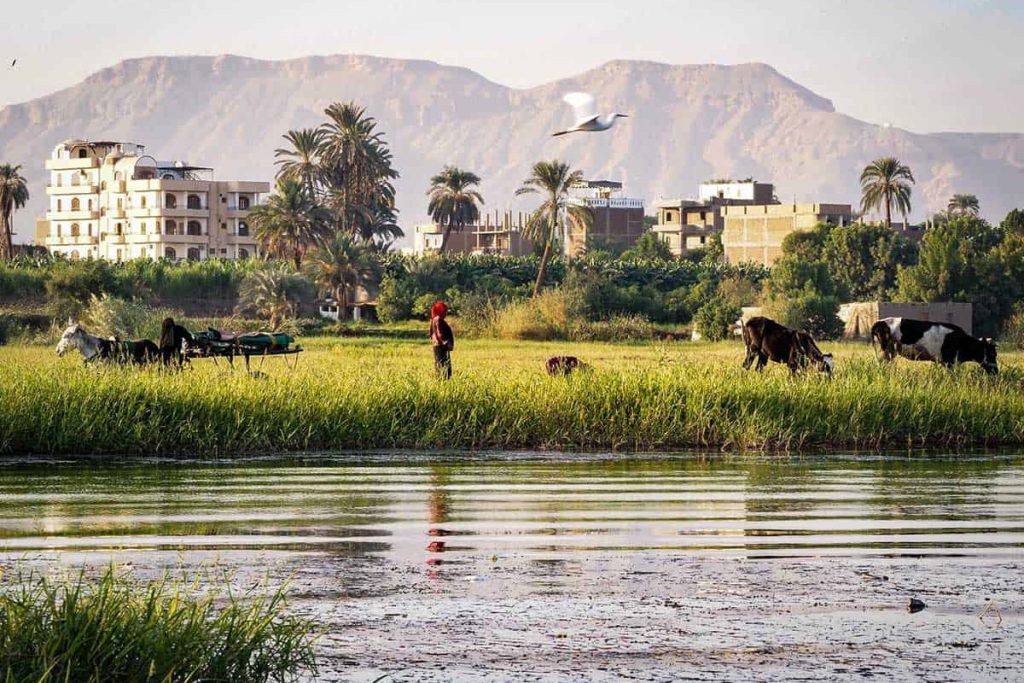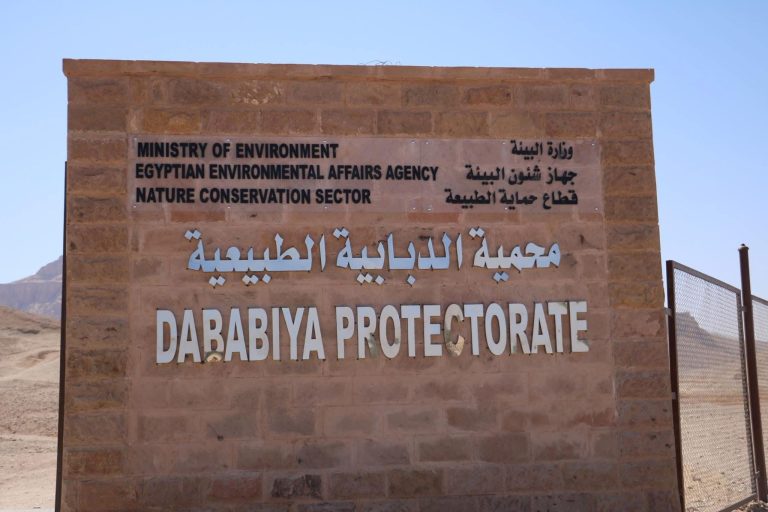Wildlife in Luxor, Egypt
Luxor is more than stone and sand
Luxor is famous for its magnificent temples, royal tombs, and the ancient legends carved in stone. However, beyond the grandeur of the pharaohs lies a quieter and often overlooked realm. Along the lush banks of the Nile, in sugarcane fields, and at the edges of the desert, a hidden world of wildlife flourishes. Here, nature and history intertwine, providing a rare glimpse into Egypt’s living heritage.

A Hidden Wilderness
Luxor is more than stone and sand — it is a land of green oases and life-sustaining waters. The Nile River carves lush ribbons through the arid desert, nurturing habitats teeming with life. Amateur photographer Ken Robinson captured this vivid contrast in a photo essay: a little owl perched in a palm tree, an Egyptian mongoose slipping silently through irrigation channels, and an African golden wolf padding across farmland at dusk. These images quietly echo the message — Luxor’s wilderness is alive, if you know where to look.
From the flower-filled gardens near Karnak Temple to the whispering reeds along the West Bank, wildlife enthusiasts, birdwatchers, and hikers find serenity and surprise in equal measure. In these thriving green spaces, birds, mammals, reptiles, and insects coexist in delicate balance with the legacy of ancient Egypt.
Luxor Tours & Activities
Looking to save some costs on your travel? Why not join a shared group tour to explore Luxor, Egypt? Here are some activities you might be interested in:

Birds of the Nile Valley
Thanks to the Nile and its network of canals, Luxor offers vital habitats to birds all year round. Between October and March, migratory species join resident birds in a seasonal symphony of movement and color. Below are some of the remarkable avian inhabitants gracing Luxor’s skies.

Pied Kingfisher (Ceryle rudis)
Easily recognized by its black-and-white plumage, the pied kingfisher hovers before plunging into the Nile’s waters in pursuit of fish. Classified as Least Concern, it still faces threats from water pollution and agricultural runoff. Birdwatchers love its aerial acrobatics, especially near the dawn-lit canals of the West Bank.

European Bee-eater (Merops apiaster)
From March to May, the sky comes alive with flashes of green, blue, and yellow as bee-eaters migrate through Luxor. Though not endangered, they are increasingly at risk from habitat loss and pesticide use. Watching them dart through the air over sugarcane fields is both thrilling and soothing.

Nile Valley Sunbird (Hedydipna metallica)
Shimmering with iridescent green and purple, this tiny nectar-lover is a vital pollinator found in Luxor’s gardens. Though listed as Least Concern, it relies on native flora, making it sensitive to urban encroachment. A sunbird feeding at sunrise in a hibiscus bloom is a snapshot of ecological harmony.

Hoopoe (Upupa epops)
With its fan-like crest and striped wings, the hoopoe is a familiar presence near fields and homes. Celebrated by locals as a symbol of good luck, it remains widespread but vulnerable to pesticide use. Spotting a hoopoe next to an ancient statue beautifully illustrates Luxor’s natural-cultural blend.

Squacco Heron (Ardeola ralloides)
Blending into the reeds with its buff-toned feathers, the squacco heron hunts in irrigation channels. While not currently assessed by the IUCN, it’s under pressure from wetland loss and pollution. Its stillness brings peace to the slow-paced waterways of the West Bank.

Grey Heron (Ardea cinerea)
Tall and elegant, the grey heron stalks shallow riverbanks for fish. Adaptable yet sensitive to disturbance, it reminds us of the quiet resilience of Nile wildlife. Seeing one wade beneath a bridge evokes the timelessness of this landscape.

Cattle Egret (Bubulcus ibis)
Often seen walking alongside livestock, the cattle egret thrives in Luxor’s agricultural zones. While adaptable, changes in farming and pesticides could threaten this symbiotic relationship. Its presence near grazing buffalo offers a picture of peaceful coexistence.

Glossy Ibis (Plegadis falcinellus)
With feathers that glint in sunlight, the glossy ibis graces wetlands during migration. Dependent on clean marshes, it’s vulnerable to urban sprawl. Watching a flock of ibises at dusk is a memory many visitors cherish.

White Pelican (Pelecanus onocrotalus)
These majestic birds fish cooperatively and arrive between October and March. While not endangered, they rely on pristine wetlands. Their soaring flight over the Nile captures the grandeur of nature in motion.

Woodchat Shrike (Lanius senator)
A skilled predator with a sharp eye, the shrike hunts from fence posts in open areas. Though stable in number, it too suffers from habitat loss and pesticide exposure.

Clamorous Reed Warbler (Acrocephalus stentoreus)
Unassuming in appearance but unmistakable in song, this reed-dwelling bird defines the soundtrack of early mornings in the Nile.

Little Owl (Athene noctua)
Nestled in temple ruins or rocky crevices, the little owl’s piercing gaze and soft calls lend an almost mythical quality to the twilight hours of Luxor.

Egyptian Vulture (Neophron percnopterus)
This endangered scavenger — once revered in ancient Egypt — is now threatened by poisoning and persecution. Its wide wings over the desert remind us of a time when nature was sacred.
Animals of the Nile Valley
Beyond birds, Luxor’s nocturnal and twilight-dwelling animals play crucial ecological roles — often unseen, but deeply felt.

Egyptian Mongoose (Herpestes ichneumon)
Depicted in tomb art, the mongoose patrols sugarcane fields and canal banks. Agile and alert, it’s a symbol of natural pest control — a timeless figure in a modern landscape.

African Golden Wolf (Canis anthus)
Often mistaken for a jackal, this adaptable predator roams the desert margins at dusk. Its quiet movements speak of a creature well-tuned to survival in a changing world.

Desert Fox (Vulpes zerda)
With oversized ears and a delicate frame, the fennec fox is nature’s desert specialist. Rarely seen, it leaves behind only subtle signs for the observant explorer.

Desert Hedgehog (Paraechinus aethiopicus)
A spiny survivor of the arid land, this hedgehog is a gentle reminder of how even the smallest creatures persist amid sand and stone.

Nile Monitor (Varanus niloticus)
Large and impressive, the Nile monitor is often found basking on riverbanks. Its presence hints at ancient reptilian lineages that predate even the pyramids.

Other Wildlife Wonders
Beyond the obvious, Luxor pulses with unseen life. Nile frogs croak in hidden pools, feeding herons and snakes. Dragonflies dart above irrigation ditches, and butterflies like the African monarch flit through banana groves, adding bright flecks of motion to the fields. These smaller species, often ignored, are threads in the complex tapestry of life here.

Challenges to Wildlife
Luxor’s biodiversity faces increasing threats:
- Habitat Loss: Expanding urban areas and tourism infrastructure erode wetlands and farmland.
- Pesticides: Chemicals disrupt insect populations, harming birds and pollinators.

Where Heritage Meets Habitat
Luxor’s wildlife is not separate from its storied past — it is part of the same legacy. From vultures honored by pharaohs to mongooses painted on tomb walls, animals have always shaped the Egyptian story. Today, they continue to thrive, echoing rhythms of the past in the rustle of reeds and the cry of a kingfisher.

Tips for Ethical Wildlife Watching
To explore Luxor’s wild side with respect:
- Rise Early: Dawn and dusk offer the best wildlife sightings.
- Use Binoculars or Lenses: Observe without intrusion.
- Stay by Water: Reeds and canals attract the widest variety of species.
- Keep Quiet and Still: Patience reveals nature’s magic.
- Support Eco-Guides: Choose tours aligned with conservation goals (see BirdLife International).
Looking Closer
The real magic of Luxor’s wildlife lies in the details: a dragonfly hovering over still water, the flicker of a sunbird’s wings in a banana grove, or the haunting silhouette of a vulture against a setting sun. These moments connect us not only to nature, but to a deeper, quieter part of Luxor itself.
Get Involved
Here’s how you can help:
- Join Eco-Tours: Support local guides who protect natural areas.
- Minimize Plastic Use: Keep waterways clean.
- Share What You See: Use the hashtag #LuxorWild to raise awareness.
- Support Conservation: Visit birdlife.org or contact Egypt’s Environmental Affairs Agency to contribute.
Did you know that
By purchasing through our links, you support us at no additional cost.
Thank you for your support. ♥️


